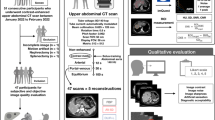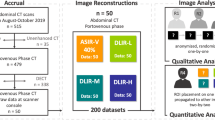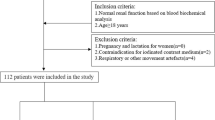Abstract
Objective
To investigate the effect of a deep learning-based denoising algorithm, PixelShine (PS), on the quality of 70 kVp pelvic arterial phase CT images.
Materials and methods
A retrospective analysis was performed on arterial phase pelvic CT images from 33 patients (body-mass index ≤ 20 kg/m2) obtained with a GE Revolution CT (70 kVp tube voltage; adaptive statistical iterative reconstruction-Veo-filtered back projection, 50% blending) and designated group A. Group B images were then obtained by applying PS to group A image datasets. Subjective image quality was evaluated by two radiologists with a 5-point scoring system; the scores of the groups were compared. Image signal was assessed using CT values of the urinary bladder. CT and standard deviation (SD) values of the gluteus maximus were measured, and SD values of the gluteus maximus were used to represent image noise. The signal-to-noise ratio (SNR) and contrast-to-noise ratio (CNR) of the bladder were calculated. Image noise, SNR, and CNR of two groups were compared using paired t-tests.
Results
The subjective visual image quality scores of groups A and B, respectively, were 3.11 ± 0.30 vs. 3.82 ± 0.57; image noise was 15.79 ± 2.05 Hounsfield units (HU) vs. 11.06 ± 2.22 HU; SNRs of bladder were 0.50 ± 0.23 vs. 0.79 ± 0.39; and CNRs of bladder were 3.72 ± 0.85 vs. 5.14 ± 1.27. Group B showed better subjective image quality, lower image noise, and improved SNR and CNR, compared to group A; these differences were statistically significant (P < 0.05). The noise of group B was approximately 30% lower than that of group A; the SNR and CNR values of group B were improved by approximately 58% and 38%, respectively.
Conclusion
Using 70 kVp +ASiR-V, PS can improve the image quality of pelvic arterial phase CT images, significantly reduce the image noise, and improve the SNR and CNR.


Similar content being viewed by others
References
Schreiner MM, Platzgummer H, Unterhumer S, et al. A BMI-adjusted ultra-low-dose CT angiography protocol for the peripheral arteries-Image quality, diagnostic accuracy and radiation exposure. Eur J Radiol. 2017;93:149–56.
Benz MR, Szucs-Farkas Z, Froehlich JM, et al. Scan time adapted contrast agent injection protocols with low volume for low-tube voltage CT angiography: An in vitro study. Eur J Radiol. 2017;93:65–9.
Lim K, Kwon H, Cho J, et al. Initial phantom study comparing image quality in computed tomography using adaptive statistical iterative reconstruction and new adaptive statistical iterative reconstruction v. J Comput Assist Tomogr. 2015;39(3):443–8.
Hasegawa A. “Noise reduction processing by AI—PixelShine”, Innervision, vol. 32, pp 31–34 (in Japanese).
Cross NM, DeBerry J, Ortiz D, Kemp J, Morey J. “Diagnostic quality of machine learning algorithm for optimization of low-dose computed tomography data”, Society For Imaging Informatics in Medicine (SIIM; June 1–3. PA): Pittsburgh; 2017.
Nagaraj Y, van Den Oever LB, Guo J, Oudkerk M, van Ooijen PM. Perceived quality measurement of low-dose lung CT after retrospective neural network image enhancement. European Society of Thoracic Imaging, ESCR, May 24-26, Geneva, Switzerland; 2018.
Pinho DF, Kulkarni NM, Krishnaraj A, et al. Initial experience with single-source dual-energy CT abdominal angiography and comparison with single-energy CT angiography: image quality, enhancement, diagnosis and radiation dose. Eur Radiol. 2013;23(2):351–9.
André F, Fortner P, Vembar M, et al. Improved image quality with simultaneously reduced radiation exposure: Knowledge-based iterative model reconstruction algorithms for coronary CT angiography in a clinical setting. J Cardiovasc Comput Tomogr. 2017;11(3):213–20.
Katsura M, Sato J, Akahane M, et al. Effects of pure and hybrid iterative reconstruction algorithms on high-resolution computed tomography in the evaluation of interstitial lung disease. Eur J Radiol. 2017;93:243–51.
Higaki T, Tatsugami F, Fujioka C, et al. Visualization of simulated small vessels on computed tomography using a model-based iterative reconstruction technique. Data Brief. 2017;13:437–43.
Benz DC, Gräni C, Mikulicic F, et al. Adaptive statistical iterative reconstruction-V: impact on image quality in ultralow-dose coronary computed tomography angiography. J Comput Assist Tomogr. 2016;40(6):958–63.
Kim HG, Lee HJ, Lee SK, et al. Head CT: Image quality improvement with ASIR-V using a reduced radiation dose protocol for children. Eur Radiol. 2017;27(9):3609–17.
Yijun LIU, Ailian LIU, Xin FANG, et al. Feasibility of low radiation dose and iodine contrast medium in 70kVp abdominal CTA in low body mass index patients. Chin J Med Imaging Technol. 2017;33(3):473–7.
Kwon H, Cho J, Oh J, et al. The adaptive statistical iterative reconstruction-V technique for radiation dose reduction in abdominal CT: comparison with the adaptive statistical iterative reconstruction technique. Br J Radiol. 2015;88(1054):20150463.
Funding
This research did not receive any specific grant from funding agencies in the public, commercial, or not-for-profit sectors.
Author information
Authors and Affiliations
Corresponding author
Ethics declarations
Conflict of interest
All authors declare that they have no conflict of interest.
About this article
Cite this article
Tian, Sf., Liu, Al., Liu, Jh. et al. Potential value of the PixelShine deep learning algorithm for increasing quality of 70 kVp+ASiR-V reconstruction pelvic arterial phase CT images. Jpn J Radiol 37, 186–190 (2019). https://doi.org/10.1007/s11604-018-0798-0
Received:
Accepted:
Published:
Issue Date:
DOI: https://doi.org/10.1007/s11604-018-0798-0




